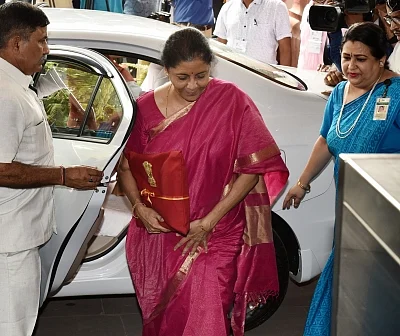New Delhi, July 19 (IANS) With an effort to keep the fiscal deficit within the budgeted limits without cutting expenditure, the off-Budget borrowings or Extra Budgetary Resources (EBRs) of the government may rise in the current fiscal where the funds would be spent more on social welfare and infrastructure projects.
EBRs are routing expenditure outside the purview of the Budget to project better fiscal discipline and keep fiscal deficit under control without compromising on capital expenditures.
In the Union Budget presented on July 5, the government cut the fiscal deficit target to 3.3 per cent of GDP for the current fiscal from 3.4 per cent. Last year, the government cut its expenditure by Rs 1.5 lakh crore, resorted to off-Budget borrowings and transferred its expenditure to public sector enterprises in order to meet its fiscal deficit target.
About 63 per cent of the spendings on railways in 2018 was incurred through extra-budgetary resources. Overall, off balance sheet borrowings have risen to 2.4 per cent of GDP as of 2018-19 from 1.4 per cent three years ago, sources said.
EBRs are borrowings undertaken by the PSUs on behalf of the government and are used to fund flagship schemes of the Centre in public welfare and infrastructure projects. Economists have argued that PSUs are free to borrow, but if the borrowing is based on a sovereign guarantee as in the case of EBRs, it has to be part of the government debt.
Since the borrowings are done on record by the PSUs and not by the government directly, the quantum is not included by the government in the fiscal deficit calculation and it goes towards the PSUs' books.
However, the interest and the principal are fully serviced by the government from the budget in the form of allocations to ministries over a period of time. Off-Budget financing make fiscal numbers look better.
On Budget paper numbers though it is different. In the interim Budget, the overall expenditure through resources of public enterprises (IEBR) was estimated at Rs 6.17 lakh crore for FY20. In the recently announced Budget, this amount has shrunk significantly, by nearly Rs 80,000 crore to Rs 5.37 lakh crore but that's only due to slashing of FCI borrowings by Rs 87,000 crore which officials said may have to be made up before the fiscal year-end.
Ministry-wise numbers also suggest that the Centre could well resort to higher off-balance borrowings to meet its expenditure by the end of the fiscal year.
The Budget 2019-20 has the inclusion of off-budget financing (including government-serviced loans of public sector enterprises). That off-Budget borrowing is going to rise to help government maintain the fiscal health was evident from this years's Budget where the government has made its intentions clear that from FY20 onwards, these off-Budget "bonds issued by PSUs on behalf of the Central government" are included in its total debt, and are thus part of the debt liabilities.
Extra-budgetary resources are expenditure incurred by the central PSUs that are given separately in the expenditure budget. "A mechanism for budgeting for EBRs has been operationalised" and EBRs have been included from BE 2019-20, as it falls within the purview of the definition of debt as the repayment of principal and interest are through the Annual Financial Statement," the Finance Ministry said in the Budget dossier.
Over the past three years, IEBR has been moving up substantially, implying that the government is increasingly using its off-budget borrowings through public sector agencies to avoid showing such borrowings in its own books.
The FY19 revealed that fresh EBRs worth Rs 64,000 crore were raised and deployed to fund the Pradhan Mantri Awas Yojana (urban and rural), a housing scheme, with a spend of almost Rs 31,000 crore; the Deen Dayal Upadhyaya Gram Jyoti Yojana, and the Saubhagya scheme, both of which are aimed at increasing electricity access, with an expenditure of almost Rs 14,000 crore; the Swachh Bharat Mission, the sanitation drive (rural), with an outlay of over Rs 8,500 crore; the Pradhan Mantri Krishi Sichai Yojana, targeted at irrigation, which has been devoted nearly Rs 5,500 crore, and so on.
Pressed between the need to accelerate growth through public capex amidst a shortfall in tax revenue and sticking to a fiscal glide path, the government had increasingly turned to extra-budgetary resources. This involves getting public sector enterprises or other such entities to borrow, with sovereign guarantee, to finance spending what should ideally have been funded from the Budget.
Any such loan allows the Centre to reduce the immediate impact on the fiscal deficit, as the repayments are calibrated over many years, although these add to the overall stock of public debt. The CAG said last year that off-budget capex and revenue expenditures understate fiscal deficit.
The Centre's fund mobilisations via EBRs are being used to finance food subsidy arrears, Pradhan Manti Awas Yojana, electrification programme, higher education infrastructure, Swachh Bharat Mission and irrigation, among a host of other such schemes. Loans taken by the FCI (mostly from NSSF) to meet its food subsidy obligations formed the largest chunk of EBRs in FY19.
--IANS
ana/sn/arm
(At The Quint, we question everything. Play an active role in shaping our journalism by becoming a member today.)
